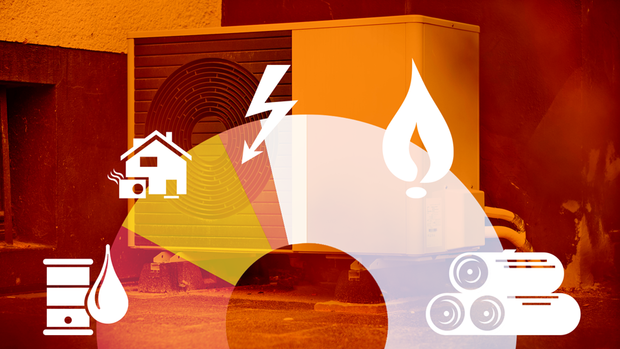Dusseldorf It seems bizarre: while millions of people in Europe have to cope with summer heat and droughts, governments are already concerned about the energy supply in the coming winter. The supply situation in Europe has been strained since the Russian invasion of Ukraine.
In Germany, Economics Minister Robert Habeck (Greens) wants to prevent a gas shortage under all circumstances. It looks good that this will work. The German gas storage facilities are currently more than 84 percent full. This means that the storage target for October 1 of 85 percent, which the Bundestag decided on Habeck’s suggestion, is already in sight.
In the following overview text you can read which energy sources Germans are currently using for heating, how the picture compares to other European countries and how sales of heat pumps will develop in 2022. This is how Europe heats up:
Gas in the largest countries, biomass in the east
The map below shows the most commonly used energy sources in Europe. The overview also allows conclusions to be drawn as to why the member states of the EU could not agree on gas sanctions against Russia despite the Russian war of aggression against Ukraine. In April 2022, the EU Parliament had already called for a “complete embargo” for Russian gas with a large majority. The Eurostat data presented below are from 2021, no new figures have yet been published for the past year.
While Germany, France and Italy, the three largest EU members as well as the Benelux countries, Hungary and Slovakia primarily use gas for heating, twelve of the 27 EU members mainly use biomass and mainly burn wood pellets, firewood and wood chips. In particular, the Eastern European countries, Spain and Portugal mostly heat with biomass.
The regional differences continue: Scandinavia relies primarily on district heating and heat pumps – i.e. on electricity. Ireland, Greece and Cyprus, meanwhile, have a particularly high proportion of oil heating systems.
The overview also shows that when it comes to heating, the European Union is still a long way from reducing greenhouse gas emissions by 90 percent by 2040 compared to 1990. This was recently requested by the Scientific Advisory Council of the EU. Even potentially more sustainable energy sources such as district heating, electricity and heat pumps are not per se climate-friendly. Because it depends on the electricity mix with which the heating energy is produced.
In Germany, for example, district heating still comes mainly from fossil fuels. In 2021, renewable energies only accounted for 17.5 percent of district heating. In Norway, on the other hand, electricity is by far the largest source of energy for heating – and the Norwegian electricity mix comes from more than 99 percent renewable sources.
You can see exactly how the European countries heat in the following detailed analysis of all EU members and Norway.
Gas heating: which EU countries are dependent on gas?
Almost all EU members also rely on gas for heat supply. Only the island states of Cyprus and Malta do not heat with gas. The Netherlands are most dependent on gas for heating with a share of 84.7 percent. In Italy (60.6 percent), Hungary (60.4 percent), Luxembourg (54.4 percent) and Germany (50.8 percent), gas also covers more than half of the heat supply. The gas share is more than a third in Belgium, Slovakia, Romania and France.
In view of the significantly reduced gas supplies from Russia as a result of the Russian invasion of Ukraine, the importance of alternative energy sources for heating is increasing. It is not only in Germany that the heat pump in particular has recently become noticeably more important.
Heat pumps: on everyone’s lips, rarely installed in Germany (yet).
However, heat pumps still account for a small proportion of the heating energy used in most European countries. When it comes to the total number of heat pumps installed, France and Italy are ahead with around 3.2 million devices, according to figures from the European Heat Pump Association.
As a result of the Russian war of aggression, business with heat pumps increased significantly in 2022: the market grew significantly last year, including in Germany. In Germany, sales of heat pumps increased by more than 50 percent. This means that the third most heat pumps in the EU were sold in Germany.
In relation to the population, however, this large number melts together: only 6.7 heat pumps were installed per 1000 households in Germany last year. In France and Italy there were 20 heat pumps per 1000 households, in Finland almost 70.
More: Split heat pump: How heating with air conditioning pays off

